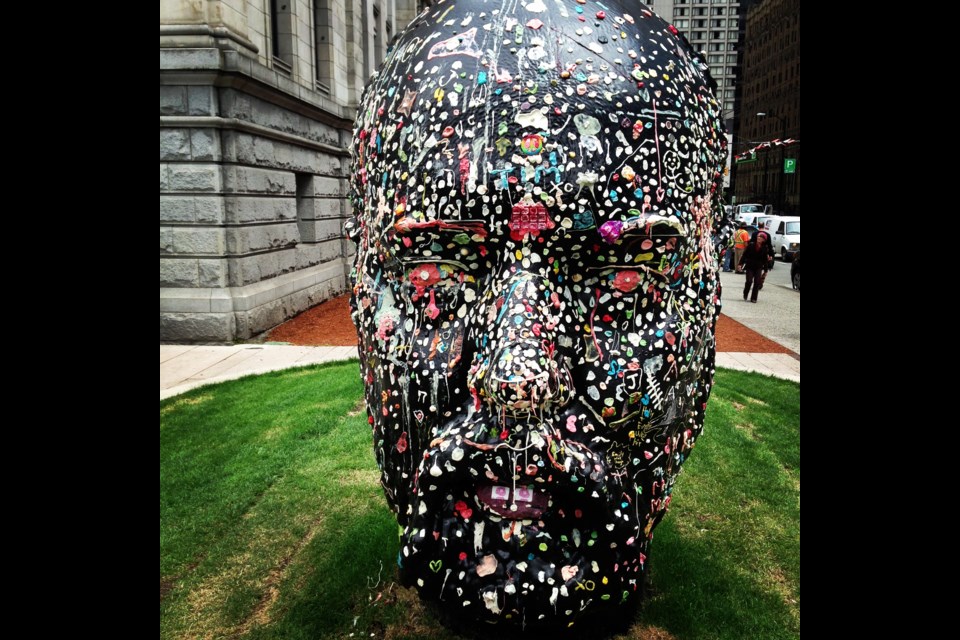If you've ever wanted to spit in Douglas Coupland's face, your opportunity has finally arrived.
Gumhead looms outside the Vancouver Art Gallery. The towering structure is modeled on Coupland's cranium and art aficionados are invited to stick their gum wherever they please and watch the sculpture grow like a Chia Pet sprouting masticated Bazooka Joe and mangled winterfresh mint.
Inside, exhibition is divided into six sections including Secret Handshake, which exists on a frequency audible only to Canadians.
There's plywood on the wall to invoke the lumber industry as well as the basement that your best friend's dad never got around to finishing. Deer antlers tangled in 8-track tape round out the room.
"I wanted to create images understandable only to Canadians. Americans should look at these photos and think, 'Everything looks familiar, and yet nothing is familiar,'" stated Coupland in a press release.
Replete with Emily Carr references, ice storm remembrances and Robin Hood flour, the exhibit delves into the challenges faced by such a huge, sprawling country.
For VAG chief curator Daina Augaitis, Secret Handshake asks the question: "What constitutes this social experiment called Canada?" Before Coupland coined the term McJobs and plumbed the ridiculousness of reality TV, he was an Emily Carr art student.
The exhibition, Douglas Coupland: everywhere is anywhere is anything is everything, is the culmination of his return to visual art after forging a career writing generation-defining satire.
Coupland was thrilled to bring his art to the VAG, according to Augaitis.
"In the many years that I've been working as a curator I've never had such an enthusiastic response at the other end of the phone," says Augaitis, whose job was trying to make sense of Coupland's prolific output. Since 2000, Coupland has sculpted, crafted word art, painted acrylic on canvas and built Lego.
The sensibility behind the books Generation X: Tales for an Accelerated Culture and Worst.Person.Ever. is apparent in each of his works.
"It's really the same Doug Coupland that you see behind all of these things," Augaitis says. "He's been very articulate in describing the effects of technology and trying to think about where it's taking us, what the future might look like."
Coupland builds the future one block at a time in Growing Up Utopian, an exhibit fashioned out of Lego.
Nearly identical Lego houses represent post-war optimism and pre-apocalypse pessimism, while crowdsourced Lego towers are a vision of the urban jungles to come.
"The ensuing hybrid buildings might well have emerged from a parallel universe, or from the year 2500," according to Coupland.
While Coupland's head is outside the VAG, his brain is inside.
The Brain is the product of 15 years of collecting toys, trinkets and Craigslist castoffs, and knowing he would eventually have to make sense of them, according to Augaitis, who called the exhibit "a cabinet of curiosities."
For Coupland, who has frequently meditated on the difference between the pre-and post-Internet brain, the exhibition is a selfie of the subconscious.
Overseen by the specters of Andy Warhol and Osama Bin Laden, the exhibit is a meditation on the oil-based economy, loneliness, and imagination.
"[Coupland is] searching to articulate and to understand the society that we've created and that we inhabit," Augaitis says.
The exhibit is a manifestation of Coupland's visual literacy, Augaitis explains.
"When you speak with him he talks about visualizing the words... so I think he's an extremely visually-oriented and visually-literate person," she says.
Shortly before beginning the interview, Augaitis says she took a peek out the window, although not to check the weather.
"It's starting to get dotted with lots of gum," she reports of Gumhead.
Douglas Coupland: everywhere is anywhere is anything is everything, will become nowhere Sept. 1. The Vag hosts an Artist's Talk with Douglas Coupland June 24, 6 to 8 p.m.


